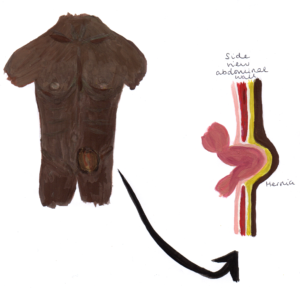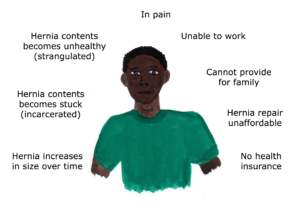Hernias Explained
What is a Hernia?
“A hernia occurs when some of the body’s internal contents push out through a weakness in the wall which contains it”.
 Common places for hernias to occur are in the abdomen or groin. A hernia can contain anything which is inside, or connects internally, with that part of the body, – for example, a groin hernia can contain fat, bowel, or even part of the bladder or the appendix!
Common places for hernias to occur are in the abdomen or groin. A hernia can contain anything which is inside, or connects internally, with that part of the body, – for example, a groin hernia can contain fat, bowel, or even part of the bladder or the appendix!
Why do they happen?
“In adults, a hernia develops over time at a natural point of weakness, through use and strain….some peoples’ body wall tissue structure means that they are more likely to develop a hernia than other people.”

Hernias often occur at natural points of weakness or joins in the body wall. For example, a common place for hernias to occur is at the umbilicus (belly button), where the umbilical cord used to be attached until just after
birth. Another common place for a hernia is the inguinal canal (groin). In a man this provided a path for the testicular structures to travel from the abdomen (where they develop) into the scrotum (where they are located in adulthood). This journey typically happens before birth. Having been important openings in the abdominal wall of the unborn baby, these are weak spots where a hernia can occur later in life.
When children have hernias, it means that they were born with them, and that the body wall never closed off fully at the point of that hernia. In adults, a hernia develops over time at a natural point of weakness, through use and strain. Not everyone will develop a hernia. However, we know that some population groups are more likely to develop a hernia than others.
Interestingly, hernias are a particularly common problem in Sub-Saharan Africa, which is likely due environmental factors (such as manual labour) as well as genetic factors (such that influence body wall tissue type).
Another cause of hernias is at sites of weakness caused by previous operations. These are known as incisional hernias.
Do hernias matter?
“A planned hernia repair can improve quality of life, protect a patient’s livelihood and prevent life-threatening complications.”
 Yes, they do! Hernias are an important health problem. Once somebody has a hernia, it never goes away (with the exception of umbilical hernias in young children). Over time, they tend to get bigger, and can in fact can become huge! If left untreated, a very small proportion of hernias can become ‘wheelbarrow’ hernias. As the name implies, these are massive and you could imagine them requiring a wheelbarrow to support them. Eventually, as much or more of the abdomen’s contents can be in a hernia than is inside the abdomen!
Yes, they do! Hernias are an important health problem. Once somebody has a hernia, it never goes away (with the exception of umbilical hernias in young children). Over time, they tend to get bigger, and can in fact can become huge! If left untreated, a very small proportion of hernias can become ‘wheelbarrow’ hernias. As the name implies, these are massive and you could imagine them requiring a wheelbarrow to support them. Eventually, as much or more of the abdomen’s contents can be in a hernia than is inside the abdomen!
However, even small hernias can make day-to-day activities very difficult, and they are often painful. This is a particular problem in Low and Middle Income Countries (LMICs), where a lot of the population work in manual jobs. In countries without a welfare state and / or income protection insurance, being unable to work means being unable to provide for one’s family.
Hernias can also develop serious complications. They can become stuck (incarcerated) and the blood supply to the contents of the hernia can be compromised (strangulated), leading to the hernia contents becoming unhealthy and even dying. If the hernia contains trapped bowel which has lost its blood supply, then this is a life-threatening emergency and the patient will not survive without an emergency operation.
A planned hernia repair can improve quality of life, protect a patient and their family’s livelihood and prevent life-threatening complications.
Why a mesh hernia repair?
“A mesh hernia repair provides a superior repair, with less chance of hernia recurrence.”
In most High Income Countries the standard way to repair a hernia is with a mesh. In the UK for example, this has been the case for over 30 years. Mesh is a thin piece of synthetic material which is placed in between the layers of the body wall. The body reacts to the mesh being there, and the result of this is that the body wall heals with more strength than if the mesh was not present.
Before meshes were commonly used, hernia repairs were carried out by attempting to reconstruct the anatomy with sutures alone. However, these techniques are actually far harder to perform and, even in the best hands, the hernia is far more likely to recur. The reasons for this are complex, but a simple explanation would be that the tissues sutured back together are already weakened, stretched tissues.
A mesh hernia repair provides a superior repair, with less chance of hernia recurrence. Whilst placing exact figures on such statements can become a lively point of discussion amongst surgeons and academics, it is widely accepted that a mesh hernia repair has a risk of recurrence in the order of <0.5% (or 1 in every 200) compared with 20-40% (1-2 in every 5) with traditional suture techniques (even in the best hands).
Are there downsides to using mesh?
 In recent years, there have been a number of media reports regarding the adverse use of prosthetic mesh in certain operations. The most significant of these have been in women requiring perineal prolapse repair. These concerns are very real and important, but should not be confused with the use of mesh in this context.
In recent years, there have been a number of media reports regarding the adverse use of prosthetic mesh in certain operations. The most significant of these have been in women requiring perineal prolapse repair. These concerns are very real and important, but should not be confused with the use of mesh in this context.
Hernia repair with mesh has been rigorously studied across the globe for decades. Whilst everything in medicine has to be acknowledged as a balance of risk and benefit. In hernia repair, the balance is very strongly in favour of the use of mesh. Whilst there are always going to be important potential side effects and complications, these are thankfully rare.
Furthermore, part of our programme is to carefully monitor the performance of the project including the short and long-term outcomes of our mesh hernia repairs.
Why a ‘mosquito net’ mesh hernia repair?
“Commercial meshes are expensive, and most patients in LMICs would not be able to afford a mesh hernia repair. The ‘mosquito net’ mesh hernia repair overcomes this problem… the project provides a sustainable way of providing the best type of hernia repair, at no extra cost to the patient.”
 The suture hernia repair method is still commonly used in LMICs, for example Tanzania. Commercial meshes are expensive, and most Tanzanian patients would not be able to afford a mesh hernia repair. Like most LMICs, the healthcare model in Tanzania is a complex one, but payment is usually required from patients for any kind of medical care. The in-country cost of a ‘standard’ hernia repair* varies from between $12 USD to over $120 USD (which is a huge amount of money for the average Tanzanian). The cost of a commercial mesh adds a further $100 – $180. For most of the population even the standard costs are challenging, with the cost of a mesh prohibitive. We are providing a sustainable way of enabling mesh hernia repair, without adding to the cost of the procedure at all.
The suture hernia repair method is still commonly used in LMICs, for example Tanzania. Commercial meshes are expensive, and most Tanzanian patients would not be able to afford a mesh hernia repair. Like most LMICs, the healthcare model in Tanzania is a complex one, but payment is usually required from patients for any kind of medical care. The in-country cost of a ‘standard’ hernia repair* varies from between $12 USD to over $120 USD (which is a huge amount of money for the average Tanzanian). The cost of a commercial mesh adds a further $100 – $180. For most of the population even the standard costs are challenging, with the cost of a mesh prohibitive. We are providing a sustainable way of enabling mesh hernia repair, without adding to the cost of the procedure at all.
The ‘mosquito net’ mesh hernia repair overcomes this problem. ‘Mosquito net’ mesh is the same material and has the same properties as commercial mesh, but costs a fraction of the price. And, importantly, it’s outcomes are just as good – there is excellent medical evidence which demonstrates this. Each piece of ‘mosquito net’ mesh required to perform a mesh hernia repair costs less than a penny! In the Affordable Mesh Hernia Surgery Initiative, the mesh is sterilised on site by the hospital team and then used. This means the project provides a sustainable way of providing the best type of hernia repair, at no extra cost to the patient.
(*For interest / contrast the cost of an open inguinal hernia repair [with mesh as standard] in the UK on the NHS is about £1500, privately it will cost upwards of £3,000)
